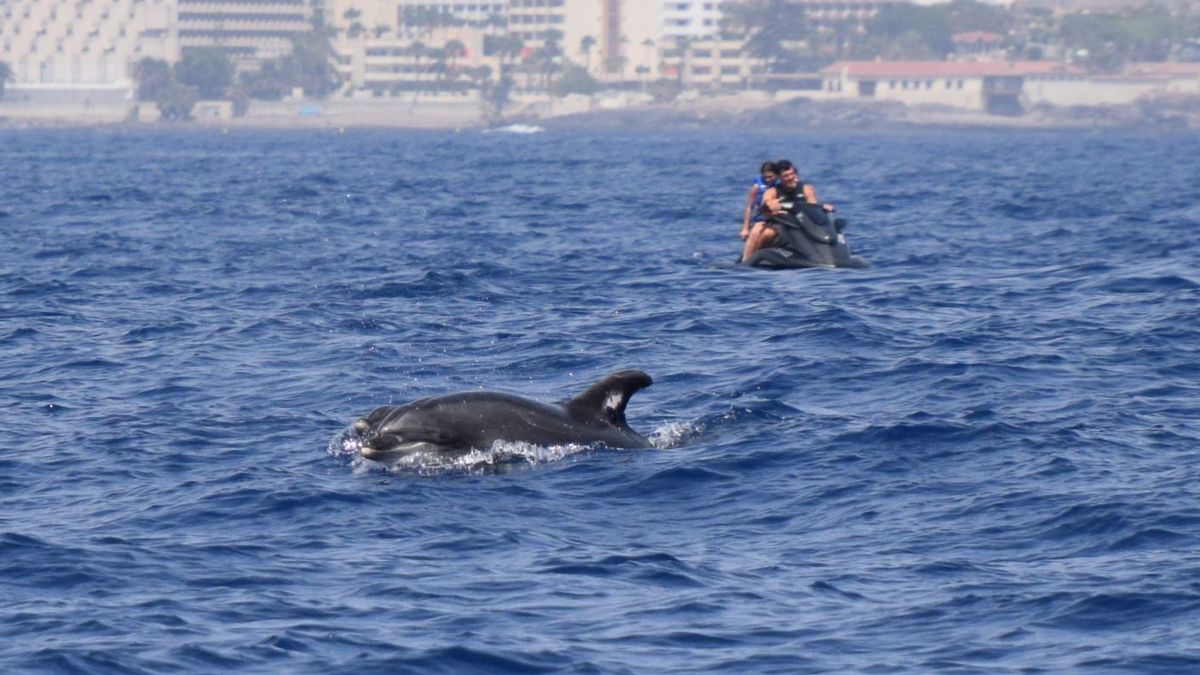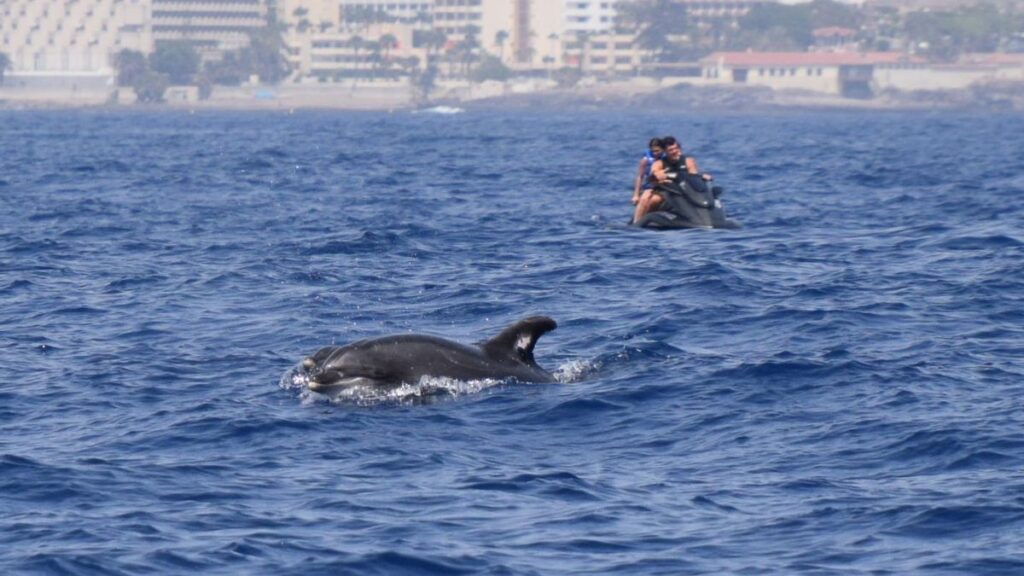Tenerife’s Coastal Paradox
One of the most heavily developed stretches of coastline in Tenerife borders the Teno-Rasca Marine Special Area of Conservation. Massive hotel complexes with hundreds of rooms crowd the beachfront in the island’s south, which welcomed over seven million tourists last year. This human pressure on land has now extended into the water. In this protected enclave where multiple conservation designations converge, dozens of jet skis race at high speed alongside threatened sea turtles, recreational boats gather to photograph tropical pilot whales, and some people even jump into the water to swim with them, violating explicit prohibitions.
Paper Protection Versus Reality
“Paper will put up with anything. We can develop different protection regimes, but if they’re not implemented on the ground, they’re useless, and I believe this is what’s been happening in this area since the 1990s,” notes David Domínguez, an anthropologist at the University of La Laguna and author of the thesis “Challenges for Marine Tourism Management: Interactions Between Stakeholders in Coastal Destinations of Tenerife, Fuerteventura and El Hierro.”
Europe’s First Whale Sanctuary
The Teno-Rasca marine strip was declared a Special Area of Conservation in 2011. This southwestern part of Tenerife is home to the continent’s largest resident population of tropical pilot whales and one of the most significant populations worldwide, with over 300 individuals. This has made it Europe’s first whale sanctuary and the third globally. The area also hosts up to 20 different cetacean species, including bottlenose dolphins, along with other endangered animals like green turtles and loggerhead turtles.
The Regulatory Framework
The Special Area of Conservation designation aims to “ensure the long-term survival of Europe’s most threatened species and natural habitats” and to “halt biodiversity loss caused by the adverse impact of human activities.” The regulations explicitly state that across this nearly 70,000-hectare area, “any activity or behavior that may cause disturbance or harm to cetaceans and sea turtles” is prohibited. But in practice, “all this tourist activity is generating a negative impact on the animals,” emphasizes a biologist and researcher who has studied the area for a decade but prefers to remain anonymous.
Documented Threats to Marine Life
“Turtles face collision risks with so many high-speed vessels above them, and uncontrolled visits to cetaceans are causing behavioral changes,” the researcher explains. These threats compound those from passenger ferries and climate change. A 2016 study by the Tonina Association in collaboration with the University of La Laguna already identified noise pollution and collisions as risk factors for tropical pilot whale conservation in the Teno-Rasca area.
This research indicates that since 1999, inter-island ferry routes have increased in frequency and speed, alongside a rise in stranded cetaceans showing signs of collision. “Other smaller boats can also cause collisions, and in this regard, the high number of high-speed recreational boats in the Special Area of Conservation is concerning,” the study notes. The presence of jet skis, recreational boats, and to a lesser extent, whale watching vessels, causes disturbance among pilot whales and reduces their resting periods. Furthermore, underwater noise can prevent animals from communicating during crucial moments like courtship.
“Inexperienced users such as tourists riding jet skis for the first time approach animals aggressively, forcing them to change their behavior to avoid them,” the study illustrates.
The Whale Watching Dilemma
Southwest Tenerife is a privileged location for whale watching, particularly for tropical pilot whales. This activity provides income for many local small business owners. However, industry sources explain that the lack of enforcement means law-abiding operators must coexist with companies conducting this activity covertly, without licenses, and without respecting distance limits from the animals.
With just a quick internet search, you can find various companies offering three-hour kayaking and snorkeling trips with turtles and dolphins in the protected area for prices ranging from €40 to €90. The Canary Islands Government approved pioneering regulations for this economic activity in 2000. This document prohibits swimming with cetaceans, staying with them for more than 30 minutes, chasing them, or feeding them. Furthermore, only a maximum of two vessels can be near a group of cetaceans, and all must carry the “Blue Boat” designation.
“Sometimes you can find up to four boats together. The critical hours start around ten o’clock,” industry sources report.
Limited Regulatory Measures
To limit the proliferation of whale watching boats in the area, the Ministry of Ecological Transition implemented a moratorium on new licenses in 2023. This decision followed various research showing that recreational nautical activity “causes chronic stress in this pilot whale community,” also impacting the development of their calves.
Raquel Modino, a professor of Anthropology at the University of La Laguna, notes this was an important step but simultaneously “a drop in the ocean.” “There’s no point issuing a moratorium for those who want to operate correctly if you don’t control those who go out with a recreational boat and position themselves right on top of the animals,” she adds. “Greater security in the area and more coordination between administrations would be desirable so people don’t feel the weight of restrictions only falls on one side,” the researcher emphasizes.
Enforcement Challenges
The administration responsible for managing the Special Area of Conservation is the Ministry of Ecological Transition. The Canary Islands Government and the Tenerife Island Council also play key roles in managing and organizing the space, along with the Guardia Civil for surveillance and enforcement.
In 2021, the Canarian Police initiated seven penalty proposals in a single day for violating whale watching regulations. However, sources consulted criticize that these raids are “sporadic.” Industry sources claim that this past August, one of the months with highest human pressure in Teno-Rasca, the Canary Islands Government’s surveillance vessel was barely present in the area.
They specifically refer to the Mar Canario vessel, acquired in 2019 by the regional government to “conduct surveillance of human activities in Marine Special Areas of Conservation and monitor species in these marine habitats.” As early as July 2024, the Association for the Conservation of Cetaceans in Southern Tenerife (ACEST) reported that this boat hadn’t left port for two months.
Education Versus Enforcement
Given the management gaps, all consulted sources point to educating businesses, residents, and tourists as a key element for protecting this space. However, they consider that relying solely on education would be like putting “a bandage on a wound that’s still bleeding.”
“Of course, products that are even more sensitive to the space should be promoted, and that’s already happening. Companies have been reconfiguring toward more sustainable strategies. But I think it’s dangerous rhetoric to believe that environmental education can achieve something while public administration doesn’t take measures to manage the space,” argues David Domínguez.
For her part, Raquel Modino reminds us that the Special Area of Conservation cannot be separated from its context and location. “Southern Tenerife is a sun-and-beach, mass tourism destination, not an ecotourism one. Visitors incorporate whale watching into their itinerary just as they incorporate partying. These are attractions added to the destination, but people will keep coming for the sun, beach, parties, or prices. Can we educate all the tourists who pass through here? No, but perhaps we could be more rigid and assign responsibility,” proposes the anthropologist.


